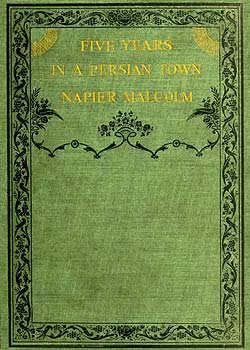 Book «Five years in a Persian town» written by «Napier Malcolm». Book Information
• Title: Five years in a Persian town
• Writer: Napier Malcolm
• Subject: Yazd, Iran
• Publication: London, 1905
• Book: 272 pages, 13 illustrations, hard cover
Authorial preface
I feel that this short sketch of a Persian town needs an apology. It will not improbably be mistaken for a book of travel. Stopping five years in on place is not travelling, and the experience of such a stay is not a traveler`s experience. The descriptions that will be found in this volume refers to a very small area, and consequently a good deal of minute work has been attempted that would have been out of place in the painting of a larger sphere.
Then, again, this is not a book upon mission work. There is comparatively little about the very interesting work which is being carried on in Yezd by the «Church Missionary Society», but there is a great deal about the circumstances under which missionaries work, for the book is really a description of a Persian town from the missionary point of View.
This will explain why certain details, such as the dress and food of the people, are left out altogether; for, although there may be some connection between these things and the kind of way in which missionary work ought to be conducted, it is not at present apparent to the writer. On the other hand, the general effects of house, street, and desert, which meet the Yezdi`s eye at every turn, have been rather elaborately described, for scenery and scenic surroundings have much effect on character, and the study of character is essential in missionary work.
In most of the descriptions I have taken special care to preserve the true proportion between good and evil, so far as I have been able to estimate it in the thing described. I have specially done this in the necessarily incomplete sketches which I have drawn of the Yezdi`s character and religious beliefs. But in dealing with the «Persian Government» I have consciously deviated from this practice. Consequently, I must ask the reader to regard all references to the «Government» as going no further than the actual statements. I have also, as far as possible, avoided alluding to political problems; for, in a country like «Persia», for a man engaged in serious missionary work abstention from politics is almost a sine qua non.
It will, perhaps, be felt by some that more ought to be made of the points in common between «Islam» and «Christianity». The fact is that when people come to the missionary they do not want to find agreement but disagreement, and consequently the missionary gets to think not so much of what they know as of what they do not know. So a missionary writer is, perhaps, inclined to pass over common points, whatever religion he is writing about.
|
|
In the case of «Islam» there are really not many to note, and in support of this statement I may relate a story told by an officer of Indian troops. One day a Mohammedan, in the course of a conversation, said to him: "Of course, Sahib, your religion and ours are very near together. Your «Christ» is one of our prophets." My friend replied: "What do you mean? Of course «Christ» is one of your prophets, but to us He is more than a prophet; He is the Son of God and the pattern of our lives. Besides, there is hardly a single practical point where Mohammedans and Christians are not entirely at issue." The man looked up and said: "Sahib, you have read the «Quran», and you have read your «Bible». I always make that remark to Christians. I made it to a padre the other day; and they almost always say: `Very true; «Mohammedanism» has a great deal in common with «Christianity».` Well, Sahib, when they say that, I know that they have not read the «Quran» and they have not read their «Bibles»."
My best thanks are due to «Miss Mary Bird», whose name is well known both in «Persia» and to all interested in that country, for the valuable assistance that she has given me out of the wide and unique experience that she possesses on the subjects handled in my book. I am also very grateful to the «Rev. G. Furness Smith» for several valuable suggestions.
I am indebted to the «Rev. C. H. Stileman» and to «Mr. Paul Peter» for some of the photographs illustrating the book. The coloured prints and the picture of the school are from drawings by a native artist, «Mirza Abul Qasim». |

